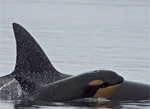Familiar hierarchy:
Resident orcas have a complex system of social grouping. The basic unit is
the matriline, which consists of a female (the matriarch) and her
descendants. The offspring of the matriarch form part of the social unit
as do the offspring of the females and so on down the family tree. Because
females can live for up to ninety years, it is not uncommon for four or
even five generations to travel together. These matrilineal groups are
highly stable over many years. Male individuals will only split off from
their matrilineal group for up to a few hours at a time in order to mate
or forage. No permanent casting out of an individual from a matriline has
ever been recorded. The average matriline size as recorded in northeast
pacific waters is nine animals.

Matrilines form loose aggregations called pods, consisting on average of
about 18 animals. Members of a pod all have the same dialect and consist
of closely related matriline fragments. Unlike matrilines, pods will split
apart for days or weeks at a time in order to carry out foraging before
joining back together.
The next level of grouping is the clan or super-pod. A clan consists of
those pods which have a similar dialect. Again the relationship between
pods appears to be genealogical, consisting of fragments of families with
a common heritage on the maternal side. Different clans can occupy the
same geographical area and pods from different clans are often recorded
travelling together.
The final layer of association, perhaps more arbitrary and devised by
humans rather than the other very natural divisions, is called 'the
community' and is loosely defined as the set of clans that are regularly
seen mixing with each other. Communities do not follow discernible
familial nor vocal patterns.
It should be emphasized that these hierarchies are valid for resident
groups only. Transient mammal-eating groups are generally smaller, although they too are based on matrilines.
However, transient groups that gather still have a loose connection
defined by their dialect.
Population types:
Modern research indicates that there are three distinct population types
or classifications of orcas. While they all look similar, they have
genetic differences, distinct food preferences and habits.
Transient:
Transient orcas have, like residents orcas, a basic social unit based on
the maternal genealogy (the matriline) but unlike residents, offspring may
disperse from the basic unit either as juvenile or adult. As a result,
transient orcas generally travel in small groups
rarely exceeding 3 to 4 individuals.

Transients are often seen cruising along the shorelines hunting for prey
like marine mammals and birds. It is this group’s ruthless hunting and
eating habit that gained orca the nick name "killer whales".
Often they will disable their prey before killing and eating it. This may
involve throwing it in the air, slapping it with their tails, ramming it,
or breaching and landing on it. The whole process can be quite lengthy at
times, seeming to be a torture for the prey, but it is primarily for their
own safety and training of the juveniles.
There exist minor variations in physical characteristics between transient
and resident orcas. For example, female transients are characterized by
dorsal fins that are pointier than those of residents. Male transients
often have scarred dorsal fins, probably from injuries resulting from
hunting and killing prey. Unlike residents, transient orcas often travel and
hunt in silence.
Resident:
Resident orcas are the most commonly sighted of the populations, often
observed in coastal waters. Female residents characteristically have a
rounded dorsal fin tip that terminates in a sharp corner.

The resident orca’s diet consists primarily of fish, including salmon and
herring. They show strong seasonal movements often associated with the
migration of their preferred fish.
Resident orcas live in complex and cohesive family groups known as pods
(groups of related matrilines). Resident pods are generally larger than
the transient and offshore pods, having up to 50 or more members (maximum). Two or
more pods occasionally join to form what are referred to as ‘clan’ or
‘super pod’, sometimes numbering in excess of 150 animals.
Offshore:
Offshore orcas remain offshore, cruising the open oceans feeding primarily
on fish. They have been seen travelling in groups of up to 60 animals.
Currently there is little known about the habits of this population, but
they can be distinguished genetically from the residents and transients.
Back